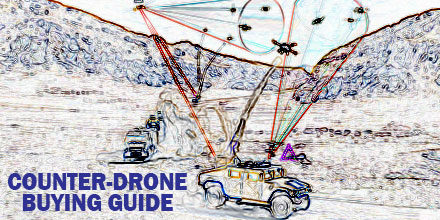DHS Issues ‘Counter-Drone’ Procurement Guide for Emergency Responders
 Department of Homeland Security’s SAVER program recently identified 13 counter-unmanned aerial systems that could be useful for emergency response.
Department of Homeland Security’s SAVER program recently identified 13 counter-unmanned aerial systems that could be useful for emergency response.
To accompany this announcement DHS also issued a guide on their features to assist procurement.
National Urban Security Technology Laboratory (NUSTL) SAVER program conducted the market survey of counter-unmanned aerial systems to help emergency responders identify useful products.
The SAVER program is designed to help emergency responders make procurement decisions. SAVER conducts operationally orientated assessments of equipment and then releases the information.
Responders use that information to select, procure, use and maintain the equipment.
Its Counter-Unmanned Aerial Systems (C-UAS) Market Survey identified 13 such products and weighed their benefits and suitability for specific purposes.
Counter-UAS
A C-UAS can detect, track, mitigate or classify a SUAS (small unmanned aircraft system) that is in the area.
The use of SUASs for both legitimate and unauthorized purposes is on the rise, leading to a flurry of campaigns and new regulations from the FAA in recent years. The study states that most of the SUAS-related incidents reported to law enforcement involve the unintentional misuse of SUAS, and pose safety rather than security risks.
As such, the products described in the market survey offer responders the ability to track and/or mitigate SUAS that could pose a threat to public safety and critical infrastructure.
The 13 systems vary in price, ranging from $7,500 to $1.9 million.
At the top end of the scale is a 500-pound, anti-UAV defense system from Liteye Systems, which consists of a radar sensor, EO suite and a directional RF inhibitor. It can detect, track, classify and mitigate SUAS by selectively interfering with its C2 channels. The stationary variant attaches to a vehicle or a mast. It includes a thermal camera and a video tracker.
Closely behind in price is the Sky Tracker from CACI international. This fixed system covers large areas by networking several systems together. The Sky Tracker uses proprietary algorithms to track and classify SUAS. The system’s RF jammer emulates SUAS signals to hijack the command and control system. Thus, preventing communication with the pilot on the ground.
Detect and Classify
Additionally, there are also options for first responders who need C-UAS that detect and classify but don’t mitigate SUAS. The study outlines the features of the Elvira from Robin Radar Systems and the UAVX from Spotter RF.
The 183-pound Elvira costs in excess of $160,000. It combines detection and classification in just one sensor, using color-coded tracks overlaid on Google Earth and then layered on a customized map. No price is listed for the UAVX, which uses video tracking and tracks SUAS in real time.
At just $7,500, the least expensive product surveyed is the Excipio Net Gun from Theiss UAV Solutions and Carolina Unmanned Vehicles. Excipio Net Gun is solely for mitigating SUAS. It accomplishes this by launching a net to either ensnare the SUAS or launching it to another location.
Of the 13 C-UAS listed, eight can detect, track, classify and mitigate SUAS. Two are just for detection, tracking and classification and three are used to mitigate only.
Before making procurement decision, the report encourages responders to know the laws in their jurisdiction which may prohibit the use of certain C-UAS features.
Access the full guide here.

